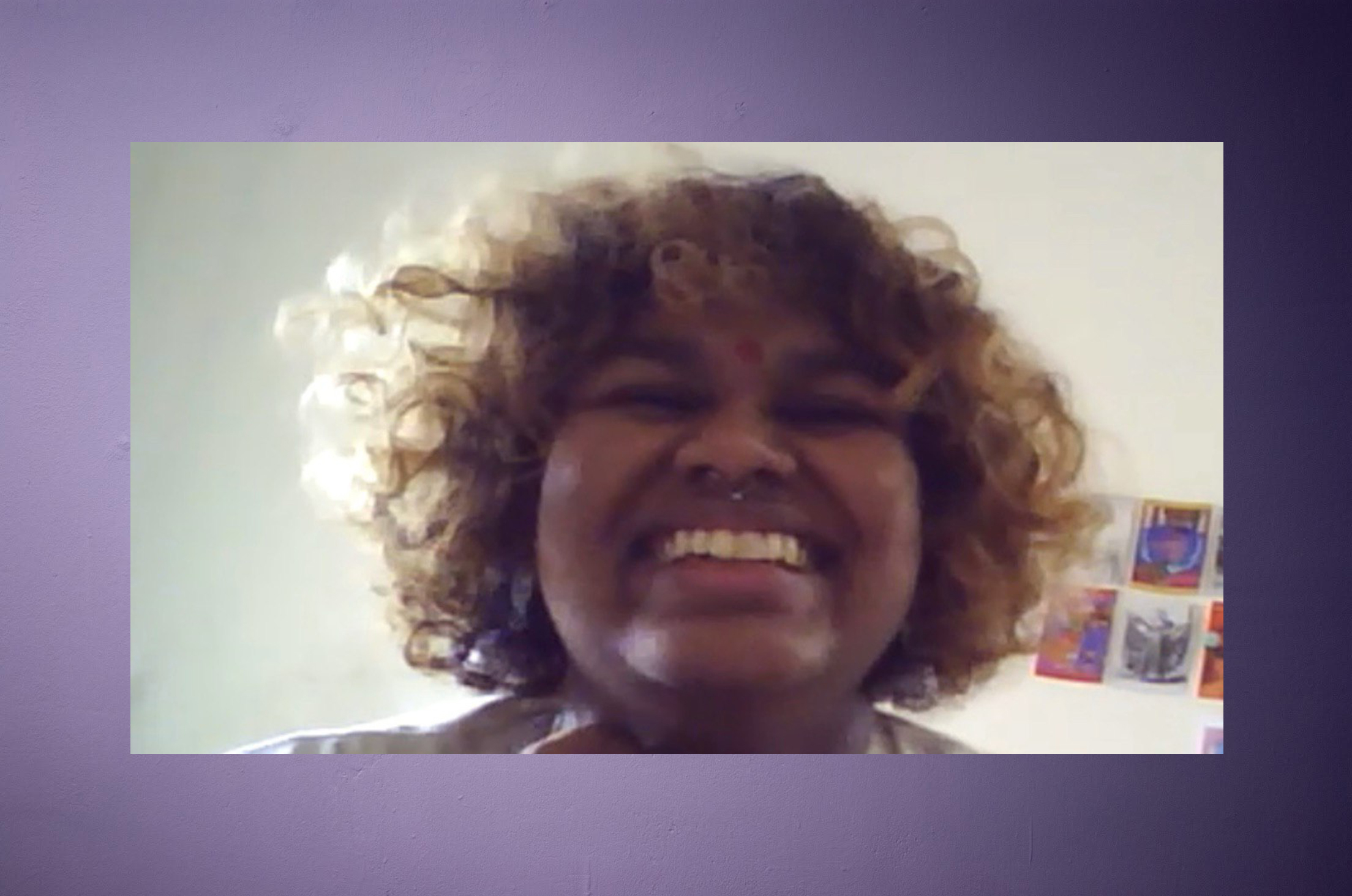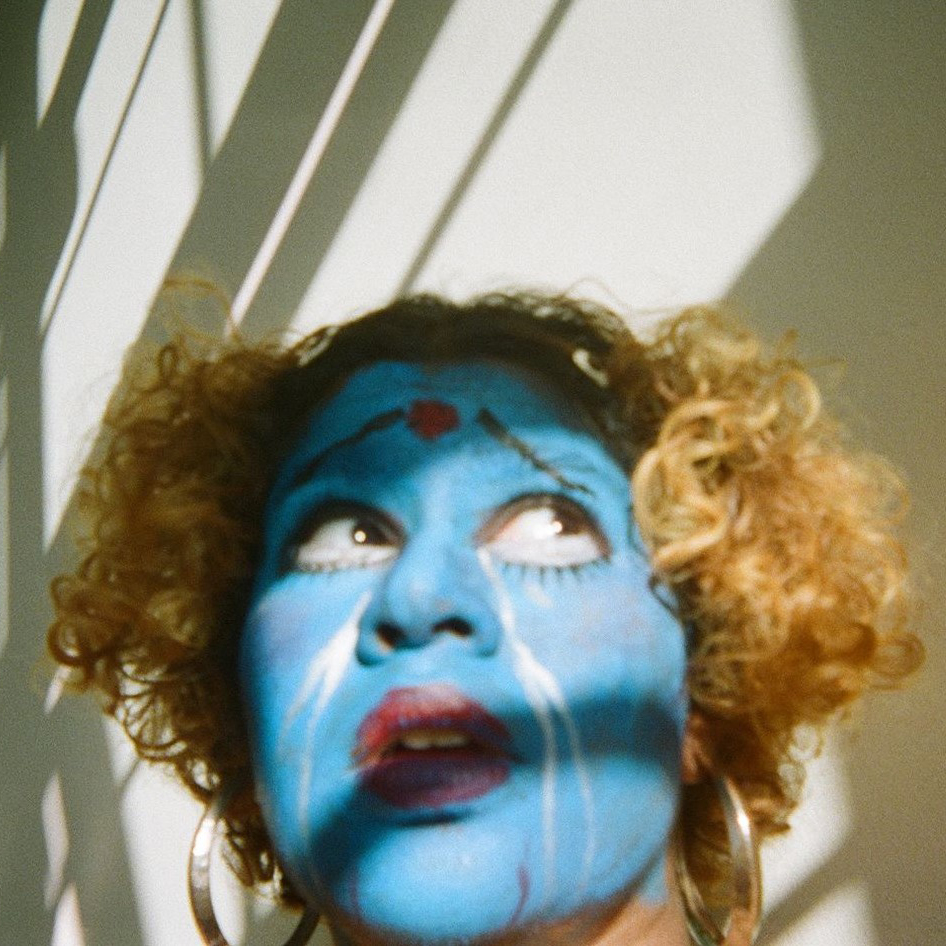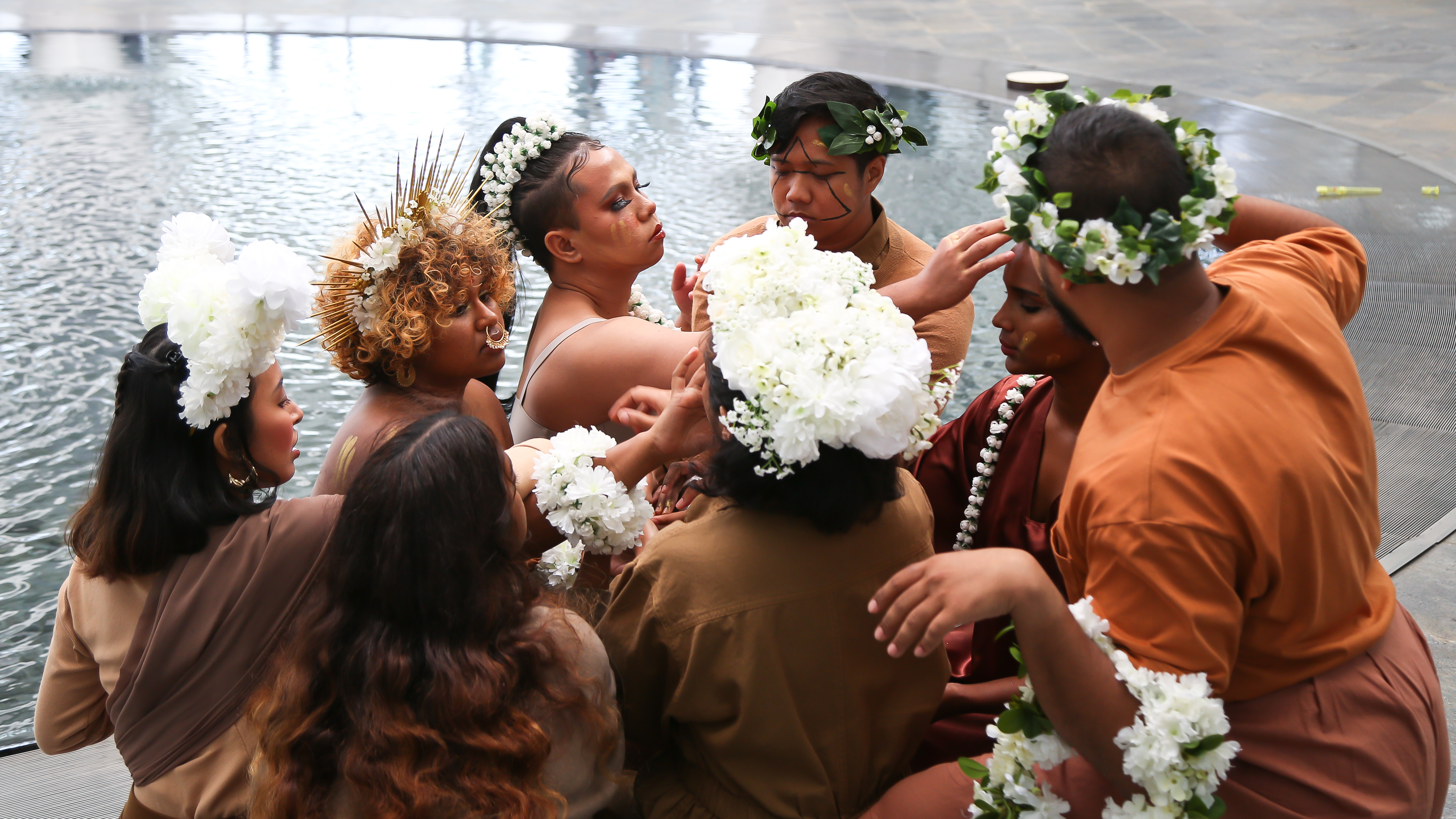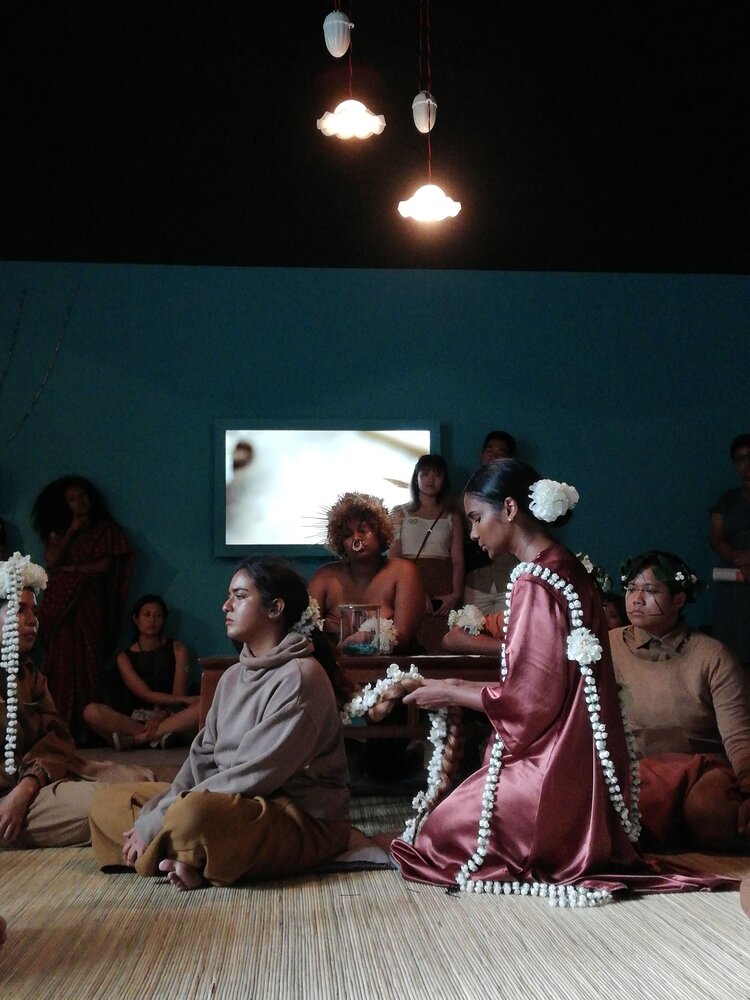Divyalakshmi (b.1999, Singapore) is an art maker whose practice traverses and reroutes timelines and bloodlines, towards a trajectory of unapologetic queer coloured futurism. Their work centers at the Dravida body and extends into photography, performance, sculpture and more.
Divyalakshmi’s inspirations are an eclectic selection spanning Youtube drag performances, social media galleries, and queer romantic comedies. We’ve first encountered their work on Instagram, which serves as a site of collision of their influences, surreal and dazzling. From across the screen, the performance artist and spoken word poet muses upon the multiple and plural histories to which their work is heir.
Divyalakshmi’s inspirations are an eclectic selection spanning Youtube drag performances, social media galleries, and queer romantic comedies. We’ve first encountered their work on Instagram, which serves as a site of collision of their influences, surreal and dazzling. From across the screen, the performance artist and spoken word poet muses upon the multiple and plural histories to which their work is heir.

Where you'd Radha be! Episode 01 - Indian Lime Pickle, Radha La Bia
2019
Shahmen Suku performs as his drag alter ego, Radha La Bia, in his work Where you’d Radha be! Drag is the embodiment of a kind of bold queer visibility, and has an importance to queer culture and activism that cannot be overstated. What is the relationship between queerness and visibility to you?
There are many layers to this relationship. The very first, obvious layer, is that queer visibility is important in terms of representation, not only legally and socially, but also on an individual level. Another layer is that any amount of visibility for a queer person is also a certain amount of danger, especially for people who are not out, but even for people who are. I’m out to whoever sees my art but I'm not out to my family. I'm not out to a lot of people in my personal life.Within drag as well, it is a visibility of a persona. It is not entirely the visibility of the self; sometimes the person is totally unrecognisable outside of drag. So drag for me has a very interesting kind of visibility where one is being visible at the exact same time of being not visible.
Shahmen Suku is a Singaporean-Indian who is currently based in Sydney. In this series of work, he cooks and brings this visibility not only to queerness but to his culture, to South Indian food. Food, and especially the preparation of food, is this most intimate and domestic thing that nobody sees. I got to meet him at IdeasCity as well, which was terribly fun — they had managed to pull it off right before the COVID-19 situation escalated.
Speaking of which, you mentioned in our previous conversation that you're working on something with soft/WALL/studs, and you’ve also had to explore alternative ways of doing it because of the pandemic?
We were working on an extended workshop with the people from the Nusantara Archive, and it involves artists from Taiwan, Malaysia, Indonesia and Singapore. Initially, the plan was that around this time, everyone would come to Singapore and have a workshop, but that’s something that obviously cannot happen now. We’ve postponed the physical meeting for now and what we are doing now is meeting remotely, bringing forth all the projects on our own, and giving people prompts and ideas.
Back to the topic of drag, you’ve also performed in drag as the persona Sang Gila Utama?
I don’t know if I would consider that a real performance yet. It was an experiment, and something I would like to do better and figure out more. I did it for a spoken word performance.
Divyalakshmi in drag as Sang Gila Utama

You’ve worked extensively with spoken word as well as performance art as mediums. How do you see the relationship between text and performance?
I like the temporality of spoken word. It’s very in-the-moment; I change my texts to the situation, and arrange it to fit a particular performance. The text is then not even necessarily the same.
It’s very malleable and fluid. Spoken word is not as set in stone as the printed word.
I haven't had any of my poems published, so nobody can really say that I’ve done something wrong, or that I’ve done something differently. I think that different spaces requires different interpretations.
It’s very much like theatre in a way, because even though there is a script, every time a production is done there exists a different interpretation. I did theatre when I was my secondary school. When I wanted to go to LASALLE College of the Arts, I had initially wanted to do theatre rather than Fine Arts. I changed my mind because exclusively doing theatre is just very limiting to me. I wanted to have all the control in what I do, as compared to being directed. Also productions tend to only seek out one Indian person, who will then play every Indian character in all subsequent plays. It would have been impossible to find work.
You work a lot with identity, especially with regards to race and gender. The multiple layers of identity is something that you constantly muse upon in your work. Is culture and queerness reconcilable to you?
If you go back to pre-colonial times, to a two-spirited Native American person, a Bugis person or a Hijra, and ask them if they are queer, they won’t really be able to answer that question. That wasn’t something that existed. The whole idea of queerness as a separate category of human is a colonial construct. I think it’s more about reconciling what has been taken from us and trying to build a culture of queerness. Even now, when we have a lot more visibility of queerness and queer culture, what we have are very much imports. In Singapore, we still associate queer culture with pride parades, RuPaul’s Drag Race, and Queer Eye. We need to also remember that much of this comes from black culture, and that white gay culture has taken a lot from black and Latinx people.
I suppose the same thing is done here, though it is not out of the desire to appropriate, but rather out of necessity for some form of expression. Our modes of expression were taken from us by colonialism. What I am working on is finding forms of queer expression that are congruent with our culture. India has gone through so many rounds of erasure of histories. Brahminical patriarchy pushed sex workers, dancers, artists, and any kind of indigenous people and beliefs to the bottom rung of the ladder. It is a history of men removing women's agency from the arts, and removing their ways of making a living.
How do we reconcile this? We cannot really go back and find out what we've lost. That is a really long process and I don’t really have the answers. I don’t think anyone has the answers, but within my lifetime, I would like to have a stepping stone towards something in that direction.
I’d like to work on rerouting timelines and bloodlines: how do we regain what colonialism, white supremacy, and Brahminical patriarchy have taken away from us?
The Sun rises in molten gold (contemplation/reclamation), Priyageetha Dia, Mysara Aljaru, Chand Chandramohan, Div, Divaagar, ila, nor and Atiq Lukman
2020
2020


Kalanjay Dhir also draws heavily from cultural rituals, and the histories of the places and identities that he grew up with, in his practice. There is in turn a sense of rituality in your pieces Kannagi and Ritual Labour. How do you see rituals and what makes you gravitate towards that as a resource?
In both our works, ritual is something that is linked to a place of comfort and to home. Some of our earliest memories of home would be of our grandparents teaching us rituals as a way to spirituality. You do these things, and that is how you have a spiritual connection with God and the forces of the universe. It's a very powerful thing, but it is also the ground for a lot of tension. Within Hinduism, it is always the women who do the spiritual labour in the house. I can’t really talk about Islam or any other religion, but growing up in a Hindu household, it is always the women — the mothers and grandmothers — who take care of the spiritual. However outside the household in temples and such, women are not allowed to do so much — especially when you’re on your period. It is a very male-governed ecosystem, which is not how it always was.
Ritual Labour is about the unseen labour and generational trauma of women who do so much work but are never recognised for it. It is not just women who do such work, of course. I am non-binary, but I still have to do feminine-coded labour. When my mom passed away, I was about thirteen. Immediately, I had to take over the spiritual, domestic role that had previously been assigned to her. It was difficult, and it is still something that's quite hard to navigate. I will never completely fill her role, because obviously I am not the same person, but it will also take a long time before I can do a proper job. I’m also too young to know whether maintaining that role is something I even want for myself.
You’ve also picked out Ananya Iyer Pandya for our conversation, whose work is centered around the coming-of-age experience, and especially Indian-American womanhood.
Anaya works with a narrative that is just not very frequently explored. The narrative around brown femme bodies is very much centered around beauty and being uplifting. The work I’ve done with Priyageetha Dia literally involves us covering each other in gold, and we uplift each other into almost-deities. What Anaya talks about is a very human aspect of the brown woman, which is just as important.
For me and a lot of Indian people growing up in the diaspora, there is this burning desire to just be normal, but we are also never be able to fit in.
This difficult navigation is not being represented. I haven't seen any other creator tackle the issue of the Indian diaspora or of any diaspora in such a way. Anaya talks about her ancestry and about her mother and grandmother. She writes these things that are just so surreal and ridiculous, like, “When my grandmother was sixteen, she went to Tokyo and she taunted all the old ugly gross men and she said, ‘I'm too good for you.’” Obviously, I doubt that any of this really happened, but she allows the Indian woman to be something that nobody allows her to be. It’s a challenge to how we perceive ourselves and others.
She’s very early on in her journey as an artist and I'm very excited to see where she goes and what she does. I have a lot of genuine admiration for what she does.
FLUX, Divyalakshmi
2019, Installation View at Coda Culture
Photography: Divaagar
Ritual Labour, Divyalakshmi
2019, Installation View at Coda Culture
Photography: Gerald Goh
2019, Installation View at Coda Culture
Photography: Divaagar
Ritual Labour, Divyalakshmi
2019, Installation View at Coda Culture
Photography: Gerald Goh


The reality of experiences, and especially marginalised experiences, is something quite central to your work as well. You work with the body, as a site upon which these experiences unfold. What about the body is particularly interesting to you?
The body is my medium. I don’t know if you’ve seen The Watermelon Woman. It is a film by Cheryl Dunye, a black American filmmaker. She finds this picture of a black woman holding a watermelon, and is fascinated by her. The character she plays goes to all these archives and researchers to try to find out more about this watermelon woman, and also finds out what it was like to be a black queer woman in her time. At the end of the film she concludes that this watermelon woman was born in a certain part in Georgia, and was a lesbian who eventually found a partner — but all of this was of course not real. It was not real in the sense that we had no evidence to support that this woman was a black lesbian in the American South at that time. That is a really unsatisfying end, so the director, playing herself, tweaks it such that she finds the watermelon woman to be a reflection of herself.
That’s essentially how I see performance art and my art. It’s very much the same kind of navigating familial and ancestral history in Southeast Asia, and queer Tamil history. I do want to provide representation as a non-binary, queer Tamil person; but I am quite boring as a person, so I spice things up a bit. The woman in the watermelon photo might not have been the person that the filmmaker said she was, yet there were definitely black lesbians around at that time. Whether it was this particular person didn’t really matter because she is a representation of what was but couldn’t be seen. That is also something that is present in nor’s work, Past & Present Lives of _______, where she plays out her past lives through these women. Some of these are real historical figures, and others are random people that we don’t have proper evidence of having existed.
I see my practice in that same way, in terms of using the body as a medium to project what I would like to see. As a queer person and as an Indian person, everything is so focused on the body. You grow up thinking about the colour of your skin, and about the way your brain operates. Why are you attracted to the people you are attracted to? Why do you feel disconnected from your body in certain ways? That's just where my fixations naturally lie, and that is how we are socialised. Another reason why I think my practice is so fixated on my body is because this is simply my experience.
The word kala often appears in your work — from what little I know, it is often used as a derogatory term. What do you find significant about this word? What is your relationship with it?
Yet the name of the goddess Kali comes from the word kala, there's a Javanese deity called Batara Kala, and the Sanskrit word kāla means “time”. Zarina Muhammad also explores this word in her work, Pragmatic Prayers for the Kala at the Threshold. I like this word because it speaks to so many things: to the experience of being marginalised, to spirituality, to time and death and renewal. It connects me to both the one place that I live in and the place that I come from. I think kala is a word that can be almost infinitely expanded upon.
Out of sheer convenience, it is also something that encompasses all dark-skinned Indians.
It’s very hard to talk about Indian identity, because within this massive landmass and its diaspora, we have so many different ethnicities and cultures.
Everything has been lumped under the label of Indian, but a lot of people that we think of as Indian are not actually from India. I’m not from India. People sometimes use the word desi, but it rings a bit nationalistic. Terms such as “Hindustan” and “Hindi” equate the idea of India with Hinduism. Especially with the place that Hinduism has in India right now, being associated with the BJP, it makes me rather uncomfortable. When I'm talking about my community that I want to uplift — the Tamil, Telugu, Bangladeshi, and Nepalese people — I feel that kala encompasses most of them. It is understood that kala means dark-skinned, which generally refers to the marginalised categories. I suppose that is my more practical understanding of it, other than the more artistic, theoretical way that I’ve mentioned earlier; but I just like the word.
